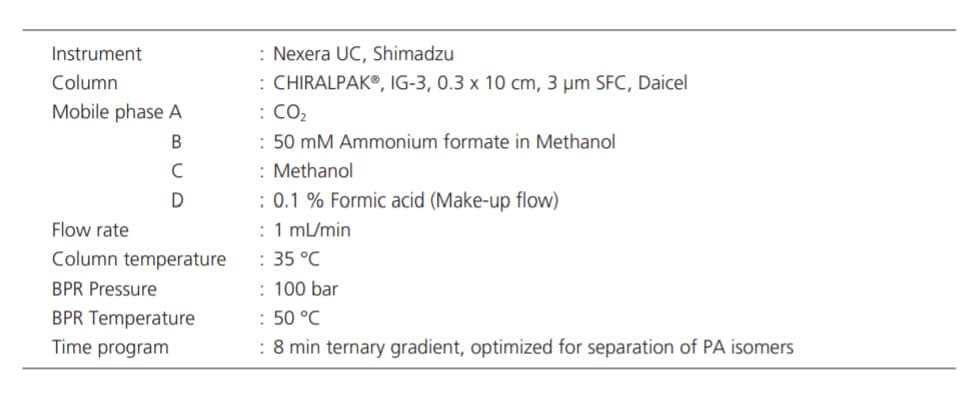It's a Special Milestone - Shimadzu (Asia Pacific)'s 35th Anniversary!
Determination of pyrrolizidine alkaloids in plant material using SFC-MS
- Development of a method for pyrrolizidine alkaloids (PAs) using supercritical fluid chromatography coupled to MS/MS.
- Separation of isomers by use of a chiral column.
- Quantification of 34 PAs in the range of at least 2 to 200 µg/kg. For all analytes, weighted regression resulting in r² 0.99 could be achieved, with S/N >10 for LLOQ levels.
Pyrrolizidine alkaloids (PAs) are potentially carcinogenic plant metabolites. They occur mainly in plants of the Boraginaceae, Asteraceae and Fabaceae families. They contain a pyrrolizidine core and make up a large group of heterocyclic alkaloids mainly derived from the 4 Necin bases platynecine, retronecine, heliotridin and ontonecin. PAs are hepatotoxic if they carry a 1,2-double bond as well as an esterified side chain which is a structural prerequisite for their hepatic activation. Exposure to PAs in food, beverages or phytopharmaceuticals, is a possible long-term concern for human health. Based on available data the Panel on Contaminants in the Food Chain (CONTAM) have proposed a list of PAs to be monitored in foodstuffs [1]. Since some of the analytes are isomers that can’t be distinguished by different mass, they have to be separated chromatographically. LC-MS/MS is the standard method for determination of PAs. However, separation of these compounds often poses a challenge. SFC offers complementary chromatographic selectivity to RP-LC and an advantage for separation of stereoisomers, shown in the development of a separation method for determination of 34 PAs including 5 Lycopsamin and 2 Senecionin isomers.
Methods and Materials
Sample Preparation
Tea samples were extracted twice with 0.05 M sulfuric acid by sonication. The pH of the combined extracts was adjusted with ammonium hydroxide before the samples were subjected to a solid phase extraction (SPE)
SPE method
Tea samples were extracted twice with 0.05 M sulfuric acid by sonication. The pH of the combined extracts was adjusted with ammonium hydroxide before the samples were subjected to a solid phase extraction (SPE)

SPE method
After elution the extracts were dried in a stream of nitrogen at 50 °C for about 60 minutes. The samples were reconstituted with 1 mL methanol and mixed thoroughly. Before transfer into an autosampler glass vial the samples were centrifuged for 10 minutes.
SFC method

SFC method
MS conditions

MS conditions
Result
Development of the SFC-MS/MS method
The main mobile phase used for SFC is supercritical carbon dioxide, to which polar organic solvents (modifiers) are added to control solubility and polarity. Also ionic additives in aqueous or organic solution can be used to adjust selectivity. Method scouting for the 34 different PAs was performed by testing 32 combinations of stationary and mobile phases (a set of four different columns from the Daicel CHIRALPAK® series and eight different modifiers). After identification of the most suitable combination for the separation of the 34 PAs, gradient conditions, flow rate and column temperature were optimized to achieve baseline separation of all isomers in a minimized overall analysis time (Figure 1).

Figure 1: Typical chromatogram of the SFC-MS analysis of 34 pyrrolizidine alkaloids
Quantitative analysis of tea samples
By using the reported instrument set-up, quantification of 18 PAs and 16 of their related N-Oxides could be achieved. Calibration curves in black tea matrix (determined in duplicate) showed good precision and accuracy. Even in a complex matrix like tea we were able to easily quantify the PAs in the range of at least 2 to 200 µg/kg. For all analytes, weighted regression resulting in r² > 0.99 were obtained, with S/N > 10 for LLOQ levels.
Exemplary calibration curves are displayed in Figure 4. Figure 3 shows chromatograms of the separation of Lycopsamin and Senecionine isomers. Table 1 states LLOQs for the different PAs.
In an application example, a total of 10 commercially available tea samples were analyzed. In 4 out of the 10 one or more of the pyrrolizidine alkaloids could be detected above their LLOQ. Europine, Heliotrine, Lasiocarpine and their related N-oxides were present in one sample, while Lycopsamine, Echinatin and their related N-oxides were present in 3 samples.


Figure 3: Chromatograms of the separated Lycopsamin and Senecionine isomers

caption
Conclusions
An SFC-MS/MS method for high-sensitivity analysis of 34 PAs in plant material was developed, which achieves baseline separation of 5 Lycopsamin and 2 Senecionin stereoisomers in 8 min. Applicability to food samples could be established by determination of PA content in commercial tea samples.
References
- [1] EFSA Journal 2017;15(7):4908: Risks for human health related to the presence of pyrrolizidine alkaloids in honey, tea, herbal infusions and food supplements
- [2] Method description BfR-PA-Tee-2.0/2014; Determination of pyrrolizidine alkaloids (PA) in plant material using SPE-LC-MS/MS


